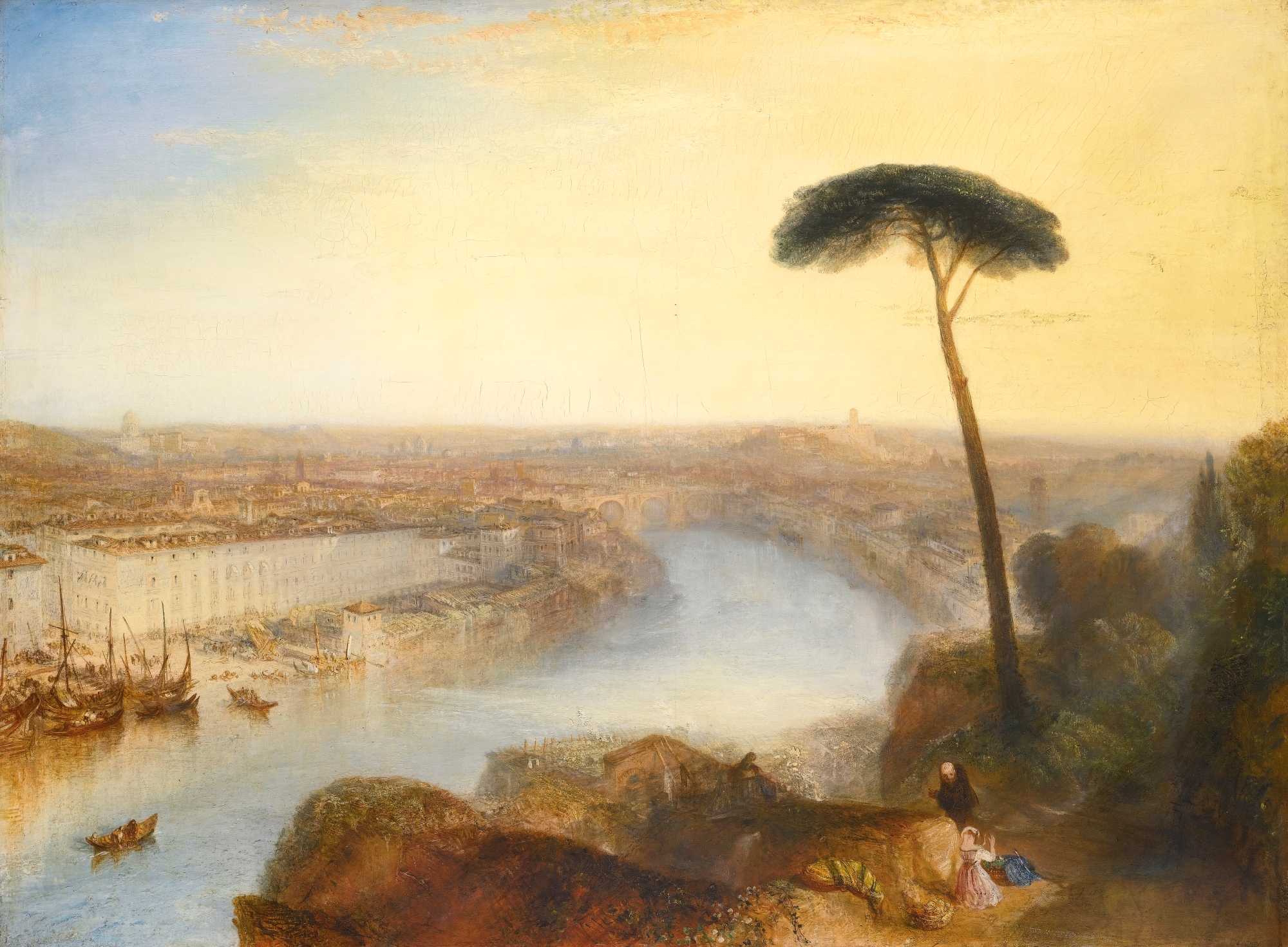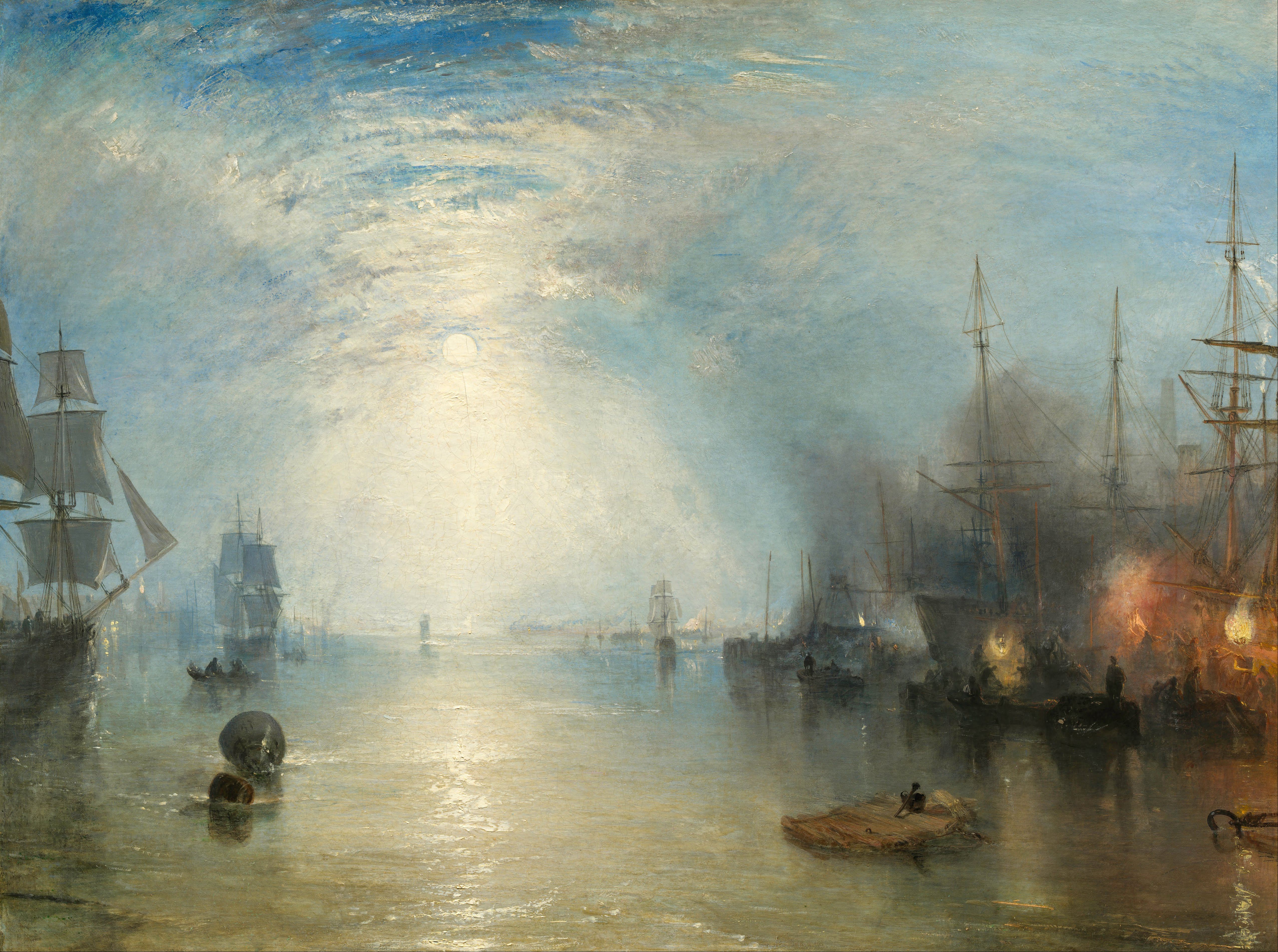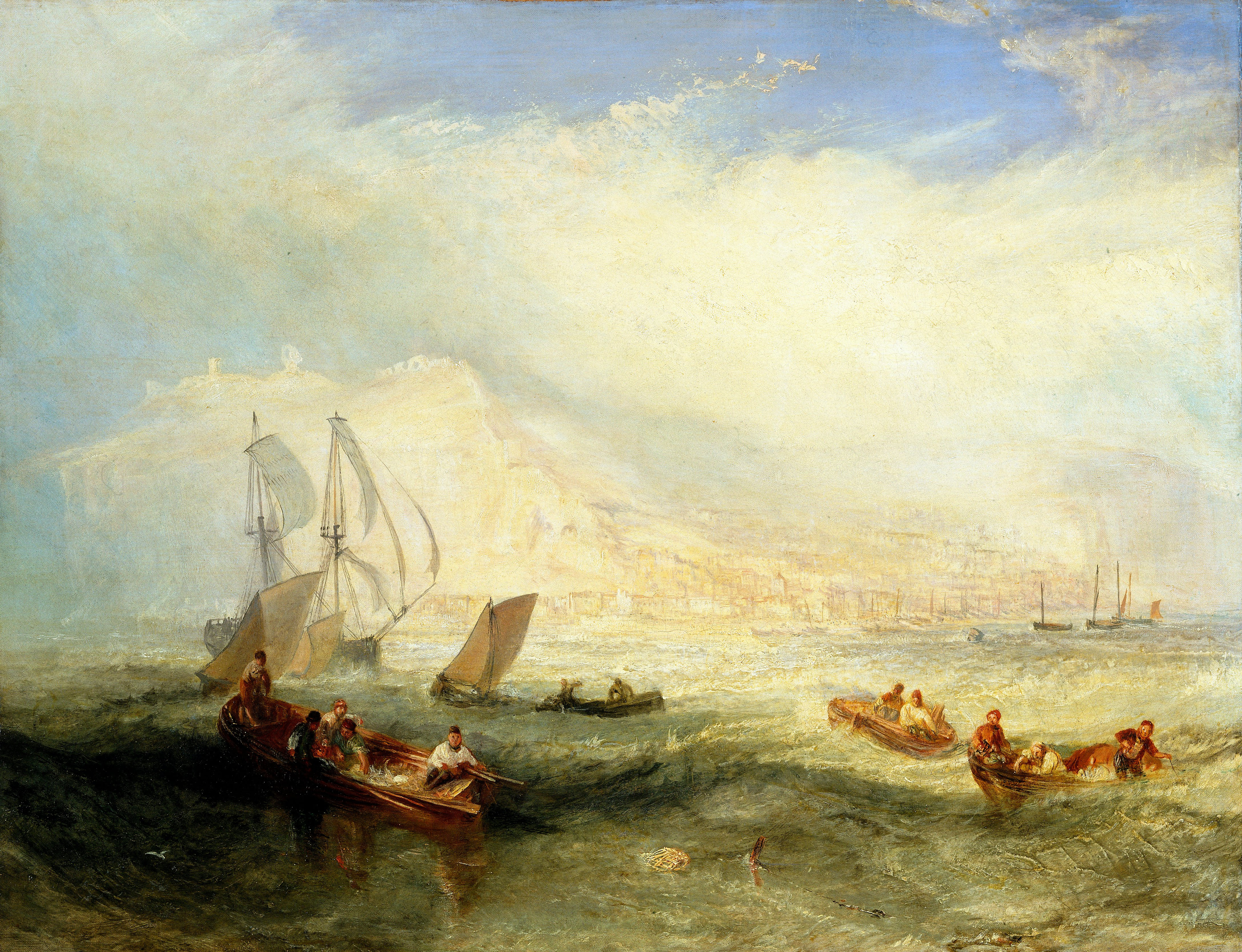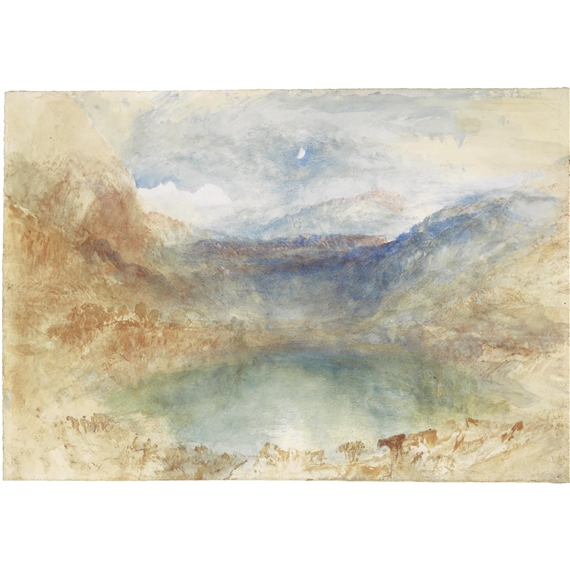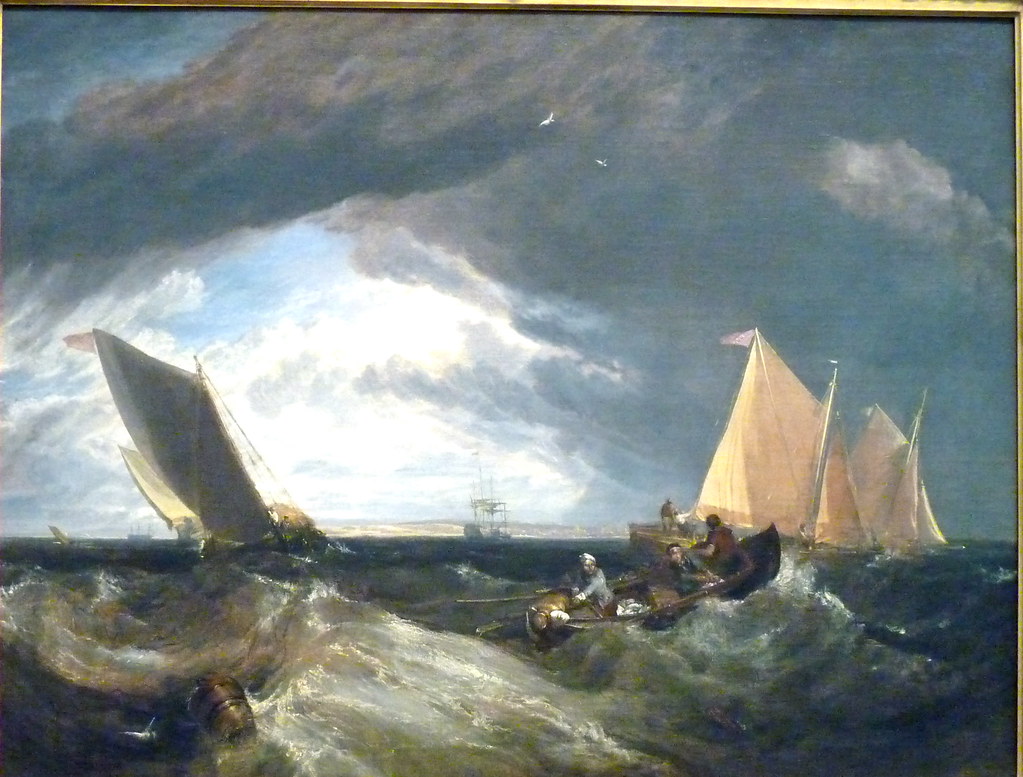Biography
JOSEPH MALLORD WILLIAM TURNER was born on Maiden Lane in Covent Garden, London, in 1775 (the actual day is uncertain, but Turner maintained it was Saint George's Day, 23 April), the only son of William Turner and Mary Marshall. His mother, who was mentally unstable, was committed to Bethlem asylum for the insane in 1800, and died in 1804. During his only sister's fatal illness (she died in 1786) Turner was sent to live with his mother's brother in Brentford and attended Brentford Free School; this was his only formal education. His early artistic talent was encouraged by his father, who exhibited his drawings in his shop window (the father remained a devoted supporter and, later, was his son's studio assistant and general factotum until his death in 1829).In 1789, the year of his first extant sketchbook from nature, Turner entered the Royal Academy Schools, also working at about this time in the studio of the architectural draftsman and topographer Thomas Malton. He exhibited his first watercolor at the Royal Academy in 1790 and his first oil in 1796; thereafter he exhibited nearly every year until a year before his death. He stayed with his father's friend, John Narraway, in Bristol in 1791, and from then on until the end of the Napoleonic Wars made frequent summer sketching tours in various parts of Britain. In 1794 he published his first two engravings, and in 1798 began drawings for The Oxford Almanack. Probably beginning in 1794 he worked for three years at Dr. Monro's evening "academy" in the company of Thomas Girtin, Edward Dayes, and others.
Turner's precocity led to his election as an Associate of the Royal Academy in 1799, and to full Academicianship in 1802. He revered the Academy all his life, was assiduous as a member of the council and hanging committee and as auditor of the accounts, and was proud to be appointed its professor of perspective in 1807, from 1811 until 1828 giving lectures that ranged widely over the problems of landscape painting. He moved from Maiden Lane to lodgings on Harley Street in 1799, opening his own gallery in contiguous premises on Queen Anne Street in 1804; this he enlarged between 1819 and 1822. In 1805 he took a house at Isleworth, keeping a second home on the riverside at intervals for the rest of his life (Upper Mall, Hammersmith, from 1806 to 1811; Sandycombe Lodge, Twickenham, from 1813 to about 1825; Cheyne Walk, from about 1846 onward).
Turner made his first journey abroad in 1802, traveling through France to Switzerland, and studying in the Louvre on his return. In 1817 he visited the Low Countries and subsequently traveled more frequently on the Continent (until 1845), less frequently in the British Isles (until 1831). Between 1819 and 1820 he paid his first visit to Italy, staying principally in Venice and Rome; he revisited Venice in 1833, 1835 (probably), and 1840.
He worked continuously for the publishers of illustrated books; his illustrations appeared at intervals between 1827 and 1835. Turner made his reputation as a topographical watercolorist, sketching from nature, mainly in pencil, the sketches serving as a repository of ideas of which he might make use months or even years afterward. He was determined to raise landscape painting to the level of ideal art, closer in the hierarchy of genres to history painting, and he experimented first in watercolor then in oils with many new techniques.
For some twenty years, from about 1798, he maintained a liaison with Sarah Danby, with whom he had two daughters, but he never married. In old age, following the death of his father and close friends, he became increasingly pessimistic and morose, allowed the house and picture gallery on Queen Anne Street to become dilapidated, and finally lived largely in his cottage on Cheyne Walk, cared for by his housekeeper, Mrs. Booth. There he died on 19 December 1851. He was buried in Saint Paul's Cathedral, London.
Sotheby’s 2017
J.M.W. Turner, Ehrenbreitstein, 1835. Estimate: £15-25 million (US$18.7-31.2m / €17.3-28.9m). Photo: Sotheby's.Painted in 1835, Ehrenbreitstein is a late work, dating from a period that is widely considered Turner’s best: other works from this time now hang in the world’s greatest museums, with only a minute number of this importance and quality remaining in private ownership. The subject of enormous critical acclaim when it was first exhibited in 1835, the painting depicts the ruined fortress of Ehrenbreitstein near Coblenz – a place of special significance for Turner. Though he made many drawings and watercolours of German views, this is the most important oil painting of a German subject that Turner ever painted. The picture will be offered at Sotheby’s in London on 5th July with an estimate of £15-25 million (US$18.7-31.2m / €17.3 – 28.9m)
Often referred to as the ‘painter of light’, Turner is widely regarded as Britain’s foremost artist, whose unique and unprecedented style not only had a profound and lasting impact on British art, but was also a vital precursor to both the Impressionist and the much later Abstract Expressionist movements. (Monet openly acknowledged his indebtedness to Turner.) Major works of such astounding quality by Turner are rare on the international market.
The last example to be offered
(Rome, from Mount Aventine, painted in the same year as Ehrenbreitstein and offered at Sotheby’s in 2014) made a record £30.3 million/ $47.6 million – the highest price ever achieved for any British-born artist at auction, and placing Turner alongside Rubens and Raphael as one of just three artists from the pre-Impressionist era to have achieved prices at this level.
Julian Gascoigne, Senior Specialist in British Paintings, said: “Turner is one of those seminal figures who changed the way we see and think about the world. An artist rooted in the aesthetic philosophy and culture of his time, perpetually engaged with the art of both his predecessors and contemporaries, he was at the same time possibly the first ‘modern’ painter; who directly inspired the Impressionism of the nineteenth century, and presaged the Abstract Expressionism of the twentieth. These late works in particular, with their bold application of colour, treatment of light and deconstruction of form, revolutionised the way we perceive the painted image. By applying the techniques of a watercolourist to the use of oils, with successive layering of translucent colour thinly applied to the surface, which imbue his canvases with rich, hazy light, he gave his works an unprecedented poignancy and power that has rarely been rivalled since.”
Alex Bell, Co-Chairman of Sotheby’s International Old Masters Department, added: “This painting was one of five that Turner exhibited at the Royal Academy in 1835; the other four of which are now in some of the most distinguished institutions in the world. Of those five paintings, it was Ehrenbreitstein that caught the imagination of public and critics alike – and it’s easy to see why. Its extraordinary range and depth of colour, and typically inspired and imaginative use of light, would in any case mark this painting out as a masterpiece, but its true greatness lies in the way Turner applies his painterly genius to transform the ruins of the famous fortress into a poetic and symbolic image as resonant then as it is today.“
The area of the Rhine, and especially the fortress of Ehrenbreitstein, held particular resonance for Turner. He first visited the area in 1817 and would return many times over the years, producing countless drawings in his sketchbooks and numerous watercolours. This painting relates specifically to a series of sketches he produced during his third tour of Germany in 1833, when he travelled down the Rhine en route to Vienna and then Venice, via Salzburg.
GENESIS AND PROVENANCE
The painting was originally painted for the illustrious publisher John Pye, a close friend of Turner’s, as the basis for a large single plate engraving – one of the important select series of large prints by which the artist established his contemporary celebrity. Pye had anticipated the artist would produce a watercolour, along the lines of Turner’s previous Rhineland views. When it came to it, however, so engaged with the beauty and symbolic resonance of the subject was Turner that he felt he could only do justice to its scale and grandeur in oil, with all its depth of emotional power and complexity of diaphanous light. What he delivered to Pye was this magnificent 93cm x 123cm full Royal Academy exhibition oil painting.
Turner’s unanticipated rendering caused Pye a good deal of frustration – working up an engraving from a painting of this size and complexity was not the easiest of tasks, taking some eleven years to complete, with a number of terse exchanges along the way.
The arrangement, however, was always that the picture should be returned to Turner’s gallery on completion of the engraving, and it was here that it was seen and acquired by the man that would become one of Turner’s greatest patrons, Elhanan Bicknell.
Bicknell may well have been introduced to Turner’s work by John Ruskin, a Herne Hill neighbour and a staunch advocate of Turner’s work. In the space of just two years, between 1841 and 1844, Bicknell acquired no fewer than seven large-scale masterpieces by Turner – the majority of which now hang in some of the world’s greatest museums, including Tate Britain, The Yale Centre for British Art, The Frick Collection, and The Metropolitan Museum in New York (see below for full details).
On his death in 1863, Bicknell’s vast collection, including this painting, was dispersed at auction, generating huge excitement and achieving sensational prices. Since then the work has appeared only twice on the market, most recently in 1965, when it achieved a price of £88,000, setting a new world record for a work by the artist.
CRITICAL ACCLAIM
The mid-1830s saw the production of some of Turner’s most celebrated paintings.
The great Rosebery view of Rome, from Mount Aventine, which sold at Sotheby’s in 2014 for a record £30 million ($47.6 million), would have been nearing completion in the artist’s studio when he set to work on Ehrenbreitstein, and
The Fighting Temeraire was shown at the Academy just four years later.
In May 1835, Ehrenbreitstein was exhibited at the Academy alongside four other great works:
Keelmen Heaving in Coals by Moonlight (now in the National Gallery of Art in Washington);
Venice, from the Porch of Madonna della Salute (The Metropolitan Museum of Art, New York);
Line Fishing off Hastings (Victoria and Albert Museum, London);
and The Burning of the Houses of Lords and Commons (The Cleveland Museum of Art, Ohio).
Of all five exhibits, however, it was Ehrenbreitstein that the public loved most, and that the critics judged the best. The correspondent for The Spectator called it ‘a splendid tribute of genius to one of the champions of freedom’, whilst The Times lauded ‘the force of colour and the admirable harmony of tone [which] are not to be equalled by any living artist’.
THE SUBJECT OF THE PAINTING
More than just a landscape, Turner’s full title for the painting, Ehrenbreitstein, or The Bright Stone of Honour and the Tomb of Marceau, from Byron’s Childe Harold, reflects a passage from Canto III of Lord Byron’s epic poem, Childe Harold’s Pilgrimage – bringing together two of the most romantic figures of the nineteenth century. Turner shared Byron’s romantic sensibilities and had long held him in the greatest admiration. Also, both had lived through the tumult of the French Revolutionary wars, and both had a keen sense of the deep significance of the ensuing peace.
In the poem Byron refers to the fortress of Ehrenbreitstein in the context of his own sense of melancholy and disillusionment in the aftermath of those wars. But for Turner it would seem that the fortress represents something more positive: that peace has vanquished war. The ancient fortress, almost dissolved in a hazy light, is now but a backdrop to the enduring everyday activities of the Rhine and Moselle valleys.
Beneath the fortress can be seen the stone obelisk to the great French General François-Sévérine Marceau-Desgraviers. Having taking part in the sieges of Ehrenbreitstein in 1795 and 1796, Marceau was a French hero par excellence. At the same time, his courage and magnanimous nature won him the respect of even his greatest enemies. His funeral, just north of Coblenz, was attended by a delegation from the same Austrian army who had been responsible for his death. Like the fortress itself, Marceau has slipped into history but still represents the possibility of peace and unity in Europe.
In Ehrenbreitstein, Turner has created an image that speaks in a profound way to both the eye and the mind – a duality that is at the heart of his unique artistic genius.
A magnificent work by Joseph Mallord William
Turner, The Temple of Jupiter Panellenius– is one of the most important oil
paintings by the artist remaining in private hands (est. $12/16 million). The
work has been in the private collection of prominent fineart dealer Richard L.
Feigen for over twenty-five years, and was a highlight of the retrospective of
the work of JMW Turner RA presented in 2008 by The Metropolitan Museum of Art
in New York, The National Gallery of Art in Washington, D.C., and the Dallas
Museum of Art. The Temple of Jupiter Panellenius is one of only three oil
landscapes concerned with ancient Greece painted by Turner, and is one of less
than twenty significant paintings by the artist still held in private hands.
“The
Graphic Society, 1837 J.M.W. Turner, Bamborough Castle, watercolour, estimate:
£1.5–2.5 million*
Sotheby’s
offeried the artist’s lost masterpiece,
Bamborough Castle, on Wednesday, December 5, 2007. Described by the Graphic
Society in 1837 as “one of the finest watercolour-drawings in the world ”this
major work looks set to generate huge excitement in the academic and collecting
worlds alike. Itis expected to fetch in excess of £1.5 million. Dating from the
mid 1830s, Turner’s Bamborough Castlehas spent most of its life to date in the
possession of a distinguished private collection and, remarkably, it has not
been seen on the open market since 1872 - some 135 years. In 1872 it wassold as
part of the Joseph Gillott collection in London and realised £3,309, the
highest price ever achieved for a watercolour at the time. The Earl of Dudley
was the purchaser on this occasion but later - in about 1890 - the picture
passed into the hands of one of the great American collecting families, that of
the Vanderbilts.
The Vanderbilt family played a significant role in the history of the United States; they built a shipping and railroad empire during the 19thcentury which made them one of the wealthiest families in the world. Since entering the collection of Mrs Cornelius Vanderbilt, the watercolour has passed down through successive generations of the family while the outside world has remained mystified as to its whereabouts. Listed as untraced in Andrew Wilton’s Catalogue of Turner Watercolours published in 1979, the work has not been seen in public since 1889. Perched on an outcrop on the very edge of the North Sea at Bamborough, Northumberland, Bamborough Castle is one of England’s finest castles.
In his watercolour, Turner has chosen to show the castle from its north side, the angle which clearly portrays the height and presence of the castle’s impressive Norman walls. The formidable castle is serenely depicted as the one point of safety in themidst of a charged landscape. In the foreground, awoman and girl appear to cower from the large roiling waves while a ship struggles to reach the security of the land under the great storm clouds. In the 19thcentury the castle had a reputation for being one of the great places of refuge on the British coast during storms for sailors in distress. It actually had rooms within the walls that wereput aside for rescued sailors as well as a marine rescue party that constantly patrolled an eight-mile stretch of the coast north and south of the castle.Turner was a great admirer of such details and hecaptures the castle’s preparations with a rocket launched in the distance and people gathered at the waters-edge, ready to rescue the sailors who are rowing away from their vessel that has struck the massive rocks.
The watercolour, which measures 505x705mm, relates to an earlier pencil drawing of the castle from 1797. The work has all of Turner’s signature elements; his energetic handling of colour which is often applied in rapid scratch-like strokes, or smeared into place with his fingertips, or scratched away with the tip of a brush to reveal the paper beneath.
Henry Wemyss, Head of British Watercolours at Sotheby’s, comments: “This watercolour fully demonstrates the genius of Turner and it’s a real treat to have the privilege of bringing it to sale. Its recent re-discovery after more than a century away from the public eye, alongside its dramatic and powerful British subject, result in an incredibly rare and special work of art. The market in 1872 made it not only the most valuable watercolour, but more expensive than many Turner oils. I think the Graphic Society got it right in 1837 when they described it as ‘one of the finest watercolour-drawingsin the world.’” Research on the painting is still in progress, but it is possible that the work may shed new light on Turner’s working practices. It seems, for instance, that here Turner has backed the sheet of paper with two further laminated sheets – no doubt to strengthen the paper but also, possibly to intensify the colours he used.
The Vanderbilt family played a significant role in the history of the United States; they built a shipping and railroad empire during the 19thcentury which made them one of the wealthiest families in the world. Since entering the collection of Mrs Cornelius Vanderbilt, the watercolour has passed down through successive generations of the family while the outside world has remained mystified as to its whereabouts. Listed as untraced in Andrew Wilton’s Catalogue of Turner Watercolours published in 1979, the work has not been seen in public since 1889. Perched on an outcrop on the very edge of the North Sea at Bamborough, Northumberland, Bamborough Castle is one of England’s finest castles.
In his watercolour, Turner has chosen to show the castle from its north side, the angle which clearly portrays the height and presence of the castle’s impressive Norman walls. The formidable castle is serenely depicted as the one point of safety in themidst of a charged landscape. In the foreground, awoman and girl appear to cower from the large roiling waves while a ship struggles to reach the security of the land under the great storm clouds. In the 19thcentury the castle had a reputation for being one of the great places of refuge on the British coast during storms for sailors in distress. It actually had rooms within the walls that wereput aside for rescued sailors as well as a marine rescue party that constantly patrolled an eight-mile stretch of the coast north and south of the castle.Turner was a great admirer of such details and hecaptures the castle’s preparations with a rocket launched in the distance and people gathered at the waters-edge, ready to rescue the sailors who are rowing away from their vessel that has struck the massive rocks.
The watercolour, which measures 505x705mm, relates to an earlier pencil drawing of the castle from 1797. The work has all of Turner’s signature elements; his energetic handling of colour which is often applied in rapid scratch-like strokes, or smeared into place with his fingertips, or scratched away with the tip of a brush to reveal the paper beneath.
Henry Wemyss, Head of British Watercolours at Sotheby’s, comments: “This watercolour fully demonstrates the genius of Turner and it’s a real treat to have the privilege of bringing it to sale. Its recent re-discovery after more than a century away from the public eye, alongside its dramatic and powerful British subject, result in an incredibly rare and special work of art. The market in 1872 made it not only the most valuable watercolour, but more expensive than many Turner oils. I think the Graphic Society got it right in 1837 when they described it as ‘one of the finest watercolour-drawingsin the world.’” Research on the painting is still in progress, but it is possible that the work may shed new light on Turner’s working practices. It seems, for instance, that here Turner has backed the sheet of paper with two further laminated sheets – no doubt to strengthen the paper but also, possibly to intensify the colours he used.
JOSEPH
MALLORD WILLIAM TURNER, R.A. (1775-1851) is Britain’s greatest watercolourist
and the last few years have seen him take centre stage like never before. In
July of this year Sotheby’s offered for sale the Ullens Collection, the finest
collection of privately-owned Turner watercolours to have come to the market in
living memory, which saw the artist’s
Lungernzee realise £3.6 million.
Hot on the heels of this, a major exhibition entitled J.M.W.Turner has just opened at the National Gallery of Art in Washington D.C. This actually follows record new prices in 2006 when one of Turner’s Venice masterpieces sold for $35.8 million in New York while his
The Blue Rigi fetched £5.8 million in London.
Sotheby's 2008
Lungernzee realise £3.6 million.
Hot on the heels of this, a major exhibition entitled J.M.W.Turner has just opened at the National Gallery of Art in Washington D.C. This actually follows record new prices in 2006 when one of Turner’s Venice masterpieces sold for $35.8 million in New York while his
The Blue Rigi fetched £5.8 million in London.
Sotheby's 2008
Joseph Mallord William Turner R.A.
LOT SOLD.
51,650 GBP
Sotheby's 2013
Joseph Mallord William Turner R.A.
LOT SOLD.
4,562,500 USD
Joseph Mallord William Turner, R.A.
LOT SOLD.
266,500 GBP
Joseph Mallord William Turner, R.A.
LOT SOLD.
98,500 GBP
Joseph Mallord William Turner
LOT SOLD.
509,000 USD
Sotheby's 2014
Joseph Mallord William Turner, R.A.
LOT SOLD.
30,322,500 GBP
Joseph Mallord William Turner, R.A.
LOT SOLD.
176,500 GBP
Joseph Mallord William Turner, R.A.
LOT SOLD. 182,500 GBP
Joseph Mallord William Turner, R.A.
LOT SOLD.
266,500 GBP
Joseph Mallord William Turner, R.A.
LOT SOLD.
302,500 GB
Joseph Mallord William Turner, R.A.
LOT SOLD.
104,500 GBPNational Gallery (Washington, DC)
-
- Turner, Joseph Mallord William
- , British, 1775 - 1851
- The Junction of the Thames and the Medway
- 1807
- oil on canvas
- overall: 108.8 x 143.7 cm (42 13/16 x 56 9/16 in.)
- framed: 148 x 180.3 cm (58 1/4 x 71 in.)
- Widener Collection
- 1942.9.87
-
- Turner, Joseph Mallord William
- , British, 1775 - 1851
- Mortlake Terrace
- 1827
- oil on canvas
- overall: 92.1 x 122.2 cm (36 1/4 x 48 1/8 in.)
- framed: 111.1 x 143.2 x 9.5 cm (43 3/4 x 56 3/8 x 3 3/4 in.)
- Andrew W. Mellon Collection
- 1937.1.109
-
- Turner, Joseph Mallord William
- , British, 1775 - 1851
- Rotterdam Ferry-Boat
- 1833
- oil on canvas
- overall: 92.3 x 122.5 cm (36 5/16 x 48 1/4 in.)
- framed: 115.6 x 146 x 7.6 cm (45 1/2 x 57 1/2 x 3 in.)
- Ailsa Mellon Bruce Collection
- 1970.17.135
-
- Turner, Joseph Mallord William
- , British, 1775 - 1851
- Venice: The Dogana and San Giorgio Maggiore
- 1834
- oil on canvas
- overall: 91.5 x 122 cm (36 x 48 1/16 in.)
- framed: 125.7 x 156.5 x 14 cm (49 1/2 x 61 5/8 x 5 1/2 in.)
- Widener Collection
- 1942.9.85
-
- Turner, Joseph Mallord William (painter)
- , British, 1775 - 1851
- Keelmen Heaving in Coals by Moonlight
- 1835
- oil on canvas
- overall: 92.3 x 122.8 cm (36 5/16 x 48 3/8 in.)
- framed: 127.6 x 158.1 x 14 cm (50 1/4 x 62 1/4 x 5 1/2 in.)
- Widener Collection
- 1942.9.86
-
- Turner, Joseph Mallord William
- , British, 1775 - 1851
- The Rape of Proserpine
- 1839
- oil on canvas
- overall: 92.6 x 123.7 cm (36 7/16 x 48 11/16 in.)
- framed: 124.1 x 154.9 x 10.1 cm (48 7/8 x 61 x 4 in.)
- Gift of Mrs. Watson B. Dickerman
- 1951.18.1
-
- Turner, Joseph Mallord William
- , British, 1775 - 1851
- The Dogana and Santa Maria della Salute, Venice
- 1843
- oil on canvas
- overall: 62 x 93 cm (24 7/16 x 36 5/8 in.)
- framed: 86 x 116.5 cm (33 7/8 x 45 7/8 in.)
- Given in memory of Governor Alvan T. Fuller by The Fuller Foundation, Inc.
-
- Turner, Joseph Mallord William
- , British, 1775 - 1851
- The Evening of the Deluge
- c. 1843
- oil on canvas
- overall: 76 x 76 cm (29 15/16 x 29 15/16 in.)
- Timken Collection
- 1960.6.40
-
- Turner, Joseph Mallord William
- , British, 1775 - 1851
- Approach to Venice
- 1844
- oil on canvas
- overall: 62 x 94 cm (24 7/16 x 37 in.)
- framed: 88 x 118.4 x 12.4 cm (34 5/8 x 46 5/8 x 4 7/8 in.)
- Andrew W. Mellon Collection

